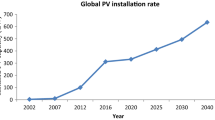Abstract
Electronic equipment generally uses heat sinks as cooling devices in order to effectively control heat arising from them. The heat sinks are commonly installed in the restricted space of the systems and their thermal performance can be improved both by enhancing the heat transfer rate and by reducing the friction factor. In the present work, a study is made to investigate the thermal performance characteristics of “S-shaped” enhancement elements. Response surface methodology is used to plan and analyze the experiments. The element height, the transverse pitch, the element radius, and the Reynolds number are chosen as variables to study the thermal performance in terms of the Nusselt number and the friction factor. In order to verify the adequacy of the model used, confirmation experiments are performed on the experimental setup. The experimental results indicate that the model used in this study is reasonable and accurate and can be used for determining the Nusselt number and the friction factor with the limitations of the factors analyzed.














Similar content being viewed by others
References
Tahat M, Kodah ZH, Jarrah BA, Probert SD (2000) Heat transfers from pin–fin arrays experiencing forced convection. Appl Energy 67(4):419–442
Sara ON, Pekdemir T, Yapıcı S, Yılmaz M (2001) Enhancement of heat transfer from a flat surface in a channel flow by attachment of rectangular blocks. Int J Energy Res 25:563–576
El-Sayed SA, Mohamed MS, Abdel-latif AM, Abouda AE (2002) Investigation of turbulent heat transfer and fluid flow in longitudinal rectangular-fin arrays of different geometries and shrouded fin array. Exp Therm Fluid Sci 26:879–900
Park K, Choi DH (2004) Shape optimization of a plate–fin type heat sink with triangular-shaped vortex generator. KSME Int J 18(9):867–876
Park K, Choi DH, Lee KS (2004) Optimum design of plate heat exchanger with staggered pin arrays. Numer Heat Transf Part A 45:347–361
Park K, Choi DH, Lee KS (2004) Numerical shape optimization for high performance of a heat sink with pin–fins. Numer Heat Transf Part A 46:909–927
Park K, Moon S (2005) Optimal design of heat exchangers using the progressive quadratic response surface model. Int J Heat Mass Transf 48:2126–2139
Chiang KT (2007) Modeling and optimization of designing parameters for a parallel-plain fin heat sink with confined impinging jet using the response surface methodology. Appl Therm Eng 27:2473–2482
Chiang KT, Chou CC, Liu NM (2009) Application of response surface methodology in describing the thermal performances of a pin–fin heat sink. Int J Therm Sci 48:1196–1205
Sahin B, Demir A (2008) Thermal performance analysis and optimum design parameters of heat exchanger having perforated pin fins. Energy Convers Manag 49:1684–1695
Sahin B, Demir A (2008) Performance analysis of a heat exchanger having perforated square fins. Appl Therm Eng 28:621–632
Jubran BA, Al-Salaymeh AS (1996) Heat transfer enhancement in electronic modules using ribs and “film-cooling-like” techniques. Int J Heat Fluid Flow 17(2):148–154
Rodriguez JF, Renaud JE, Wujek BA, Tappeta RV (2000) Trust region model management in multidisciplinary design optimization. J Comput Appl Math 124:139–154
Madsen JI, Langyhjem M (2001) Multifidelity response surface approximations for the optimum design of diffuser flows. Optim Eng 2:453–468
Kansal HK, Singh S, Kumar P (2005) Parametric optimization of powder mixed electrical discharge machining by response surface methodology. J Mater Process Technol 169:427–436
Naceur H, Ben-Elechi S, Batoz JL, Knopf-lenoir C (2007) Response surface methodology for the rapid design of aluminum sheet metal forming parameters. Mater Des 29(4):781–790
Choori W, Pattthanamanee W, Manurakchinakorn S (2008) Use of response surface method for the determination of demineralization efficiency in fermented shrimp shells. Bioresour Technol 99(14):6168–6173
Xiarchos I, Jaworska A, Traznadel GZ (2008) Response surface methodology for the modeling of copper removal from aqueous solutions using micellarenhanced ultrafiltration. J Membr Sci 321(2):222–231
Acherjee B, Misra D, Bose D, Venkadeshwaran K (2009) Prediction of weld strength and seam width for laser transmission welding of thermoplastic using response surface methodology. Opt Laser Technol 41(8):956–967
Wang G, Zhao G, Li H, Guan Y (2011) Research on optimization design of the heating/cooling channels for rapid heat cycle molding based on response surface methodology and constrained particle swarm optimization. Expert Syst Appl 38:6705–6719
Khalajzadeh V, Heidarinejad G, Srebric J (2011) Parameters optimization of a vertical ground heat exchanger based on response surface methodology. Energy Build 43:1288–1294
Subasi A (2010) Heat exchanger optimization with the helping of response surface method. MS Thesis, Mechanical Engineering Department, Ataturk University, Turkey
Box G, Wilson K (1951) On the experimental attainment of optimum condition. J R Stat Soc Ser B 13(1):1–45
Montgomery DC (1997) Design and analysis of experiment, 4th edn. Wiley, New York
Myers RH, Montgomery DH (1995) Response surface methodology: process and product optimization using designed experiments. Wiley, New York
Chen TY, Shu TH (2004) Flow structures and heat transfer characteristics in fan flows with and without delta-wing vortex generators. Exp Therm Fluid Sci 28(4):273–282
Ozisik MN (1985) Heat transfer: a basic approach. McGraw-Hill Int Ed, Boston
Kline SJ, McClinctock FA (1953) Describing uncertainties in single sample experiments. Mech Eng 75:3–8
Sara ON, Pekdemir T, Yapici S, Yilmaz M (2001) Heat-transfer enhancement in a channel flow with perforated rectangular blocks. Int J Heat Fluid Flow 22:509–518
Author information
Authors and Affiliations
Corresponding author
Rights and permissions
About this article
Cite this article
Karagoz, S. Investigation of thermal performances of “S-shaped” enhancement elements by response surface methodology. Heat Mass Transfer 51, 251–263 (2015). https://doi.org/10.1007/s00231-014-1413-2
Received:
Accepted:
Published:
Issue Date:
DOI: https://doi.org/10.1007/s00231-014-1413-2




